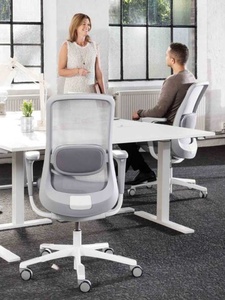With working from home becoming a real long-term option for many organisations, planning for how best to monitor employee comfort and workstation setup has become increasingly important. In the office, it can be difficult for H&S, Facilities, HR and Occ Health to allocate time to monitoring staff comfort, provide compliant DSE assessments and ensuring staff are productive. Homeworking adds a wide variety of complex and dynamic elements. All kinds of kitchen tables, dining room chairs, old office chairs and shallow desks in forgotten spare rooms are now the order of the day!
Ergonomics is all about tailoring the workplace to fit the employee’s needs as opposed to the other way around. It refers to the process of eliminating or minimizing physical stressors and environmental factors that adversely affect worker health and comfort. In today’s working world and over the next while effective ergonomics is vital to monitor employee comfort and prevent injuries arising.
With a growing variety of factors to consider when managing ergonomics within an organisation there’s an increased need for better ways to identify, manage and prevent work related discomfort and injury. With attention being pulled for tasks such as getting workplaces prepped for employees returning to the office, organising protective screens, PPE, sourcing homeworking equipment or monitoring equipment taken from the office, there is potential for ergonomics to be neglected. Now more than ever it is extremely important to give ergonomics due care to reduce the likelihood of work-related injury further down the line.
In the current climate, every organisation’s goal should be to create as time and cost-efficient ergonomic processes as possible. This article will give you some of the benefits of one of the best ways many multinational companies are doing just this - the Ergonomic Management Software provided by KOS Ergonomics.
1. Save considerable time spent managing ergonomics for H&S/Facilities/HR
Managing employee comfort is a very time and labour-intensive task at the best of times. Throw in a wide variety of factors ranging from kitchen table height to the firmness of your dining room chair and it becomes an extremely difficult task. With a variety of variables comes an increased need for a tailored approach to manage the risks to employee health that these different factors create!
Identifying and monitoring these factors has the potential to be a vary laborious process if done using an amalgamation of old-fashioned spreadsheets and questionnaires. Our Ergonomic Management Software enables employers to provide tailored education to employees based off their own workstation setup. Employee’s simply select which setup best fits their current workstation and the education portion of the software reflects their selection.


Have different people looking after different locations or with different screen setups?
The software enables organisations to segment employees based off department or location which can streamline issues being resolved. Heads of departments can get emails relevant to their team or if there are different points of contact at other location, they will only be notified of relevant issues. The education portion will be reflective of the employee's screen setup also!

Unsure of the next step following an issue being identified?
The software provides a suggested action based off the user’s answer during the self-assessment portion when they select an option from the Further Details drop-down. Each selected answer will give a suggested action in the management portion of the software, saving time in deciding what is the next step in resolving a user’s discomfort.

If no answers are relevant, there is also an ‘Other’ option for the user to input what is most relevant to their situation. This way all information can be tracked by the software with all variables being documented and accounted for.
2. Identify employees at high risk of injury to prevent their condition deteriorating further
Once all assessments are complete it can be difficult to decide where to channel your efforts. Questionnaires are okay for gathering the information, but it can be difficult even for experienced professionals to prioritise employees most in need of support.
The Ergonomic Management Software enables organisations to know exactly where to focus their efforts by identifying employees at High, Medium and Low risk of injury. This also allows companies to prioritise those at highest risk of injury who require immediate attention while enabling them to put a plan in place to resolve those at medium and low risk of injury.
Knowing where to start resolving issues can give H&S, Facilities, Occ Health or EHS a certain piece of mind and allows them to put a plan in place to get around to all employees based off their needs.

The prioritisation of risk also can be used as a guideline of deciding who should return to the office first. This process will reduce the risk of at-risk employees developing further injury if their home workstation poses risk to their health!
3. Reduce long term spend on managing and resolving issues
Getting things wrong in workplace ergonomics can result in increased future spend on managing issues that have arisen and on resolving injuries. Specialist Ergonomic Assessments take time and have a cost for the company. The specialist back care chair, sit-stand desk or specialist mouse all have a cost for the H&S or Facilities teams.
With employees now encountering more variables than ever at their workstation, the risk of injury is greater than ever. By implementing an ergonomic management software, companies can identify early on those at risk of work-related injury thus avoiding future costs associated with resolving these issues.
Unfortunately, some would argue we live in somewhat of a claims culture at the moment. With average amounts of €30,839 (PIAB, 2018) being awarded for Employer’s Liability claims in 2018, it’s clear that getting things wrong when it comes to workplace injuries or accidents is a very costly game. Putting processes in place early on to document exactly what has been done to accommodate employee’s issues is a simple and effective way to cover yourself against any future issues arising.
The Ergonomic Management Software enables organisations to have a simple yet effective system of clearly documenting the ‘Actions’ taken at different stages in the comment section. Multiple actions can be added all of which will be timed and dated by the system for the report.
Insert comment when actioned.
Have a clear paper trail of actions taken by the organisation with times and dates.
4. Improve employee morale
There’s no doubt that many difficulties have cropped up over the last few months between isolation, reduced social interactions, stresses of working from home, overworking and more! Keeping employee morale high has become a more difficult task for most companies. Many organisations have put processes in place to maintain regular contact with employees like virtual team coffee breaks over video call, online quizzes or even arranging an online yoga or exercise class!
Another method of keeping morale high is to make sure everybody is working in comfort at home and that if they are not, their issues are known by management so pans can be made to accommodate them!
If an employee is working in discomfort, they will be both unproductive and unhappy. This has the potential to not only impact their performance, but to filter throughout different teams with smaller issues having the potential to develop into much larger headaches for the company to manage.
Ensuring employees are given due care and know their comfort is a priority is vital for the company in maintaining a positive atmosphere during a difficult time. The extra attention will encourage employees to continue to work to their potential and apply themselves fully while working from home.
5. Helps organisations keep up with HSA guidance
In most cases, at a home workstation, the employee is working with what they have, rather than the environment being designed around employee and task requirements. This leads to potential hazards relating to space allocation, lighting, noise and non-compliant DSE Equipment being used. This is still the employer’s workplace but, in a homeworking environment, employers lose control and visibility over many of these factors and hazards.
So what is the Irish law regarding homeworking?
In the current working world, many things have changed. One set of things that remain the same are the HSA regulations. With homeworking, the employees home becomes the workplace. Under the Safety, Health and Welfare at Work Act 2005 (as amended) an employer has a duty of care to their employees. This includes providing and maintaining a safe workplace, preventing any improper conduct or behaviour likely to put the safety, health and welfare of employees at risk and providing instruction and training to employees on health and safety.
The employer needs to:
- Carry out a suitable risk assessment of the employee’s homework space when they commence working from home and at periodic intervals throughout their employment.
- Provide suitable equipment that is compliant with Schedule 4 Requirements.
- Provide training on safe working practice.
Has there been any changes to the guidance from enforcement bodies in light of the pandemic?
The speed of escalation of the Covid-19 crisis, has required employers to move to home working rapidly. The case can be made that the risk of Covid-19 outbreak to the employee and population is greater than moving staff into a temporary home workspace that has not been fully risk assessed. The main change is the HSA have issued Covid-19 specific guidance that there will not be the expectation that employers will provide an individual DSE assessment to every employee during the pandemic. However, this does not reduce the obligation of the employer to appropriately risk assess homeworking on a whole and make sure this policy considers how to accommodate every employee, with particular attention to vulnerable employees. Within SHWW Act, it boils down to what is reasonably practicable to implement. As time passes, what controls are reasonably practicable for an employer to implement increase.
The Ergonomic Management software enables organisations to get a grasp of overall employee comfort while also identifying their vulnerable or ‘High risk’ employees. This allows organisations to put a timeline in place within which they can immediately work to resolve high risk employee’s issues and in time resolve the medium and low risk cases.
Conclusion
Thankfully, the pandemic is beginning to subside, what is left behind is a complex mixture of factors and decisions that will determine what employee workstations will look like for the foreseeable future. Although there are many areas requiring attention at the moment ergonomics is not one that can be neglected. By prioritising their employee’s comfort, companies are putting themselves in the best possible position to succeed during very a difficult time. A lack of proactive processes is likely to result in increased spend long term, reduced morale among staff along with frustration among management due to excessive time spent managing ergonomics!
KOS Ergonomics are a team of Ergonomic Consultants that have adapted to the challenges posed by the new working world to help support clients using technology and country wide equipment support. We are currently working with many large multinational companies to help manage employee comfort during this challenging time and plan for what the future of work looks like.
We are now carrying out Software Demonstrations with several multi-national organisations with headquarters in having already rolled it out with some of Ireland’s largest organisations.
If you would like to book in for a Software Demonstration you can request one here:
During the demonstrations our consultants can also provide guidance on what similar organisations are doing to manage comfort and plan for a safe return to the office!
References



















